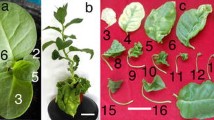Summary
-
1.
Large numbers of tumorous (auxin-autotrophic) and non-tumorous (auxin-heterotrophic) tobacco callus cultures were transferred from their culture media in darkness to media with high kinetin content in light for regeneration. There were two lines of tumorous cultures, Tc and Ta; they were started in 1946 from the tobacco variety “White Burley”. Tc had been transformed by infection with Agrobacterium tumefaciens, Ta spontaneously by “habituation”. Non-tumorous cultures (Tn 1 and Tn 2) were started in 1961 from an unknown variety of tobacco. All the four types of cultures we received from the laboratory of Prof. R. Gautheret in Paris, in 1965.
-
2.
Regeneration from tumorous cultures to fully developed plants was largely successful. These plants, however, were always sterile and none represents a genuine specimen of “White Burley”. Regeneration from non-tumorous, so-called “normal”, cultures was on the contrary very poor. The number of plants regenerated from Tn 2 was very small. The plants were more or less uniform, growing well only as scions on other tobacco plants. Only a few “teratomata” from Tn 1 developed and, in one case only, a plantlet with roots, shoots and leaves. In grafting experiments with Tn 1 teratoma as scion on “Xanthi” tobacco stock, all regenerating plants originated from material with the gene N, probably from the “Xanthi” stock.
-
3.
A comparison of the chromosome numbers of the callus cultures with those of the plants regenerated from them shows that selection plays an important part in the process of regeneration. Plants regenerated from tumorous cultures had extreme aneuploid chromosome numbers and this fact supports the assumption that abnormal chromosome numbers of tumorous cells (in the original callus cultures) are not the cause of tumor growth. On the other hand, the high aneuploidy of the regenerated plants suffices to explain their abnormal morphology and sterility. These abnormal features should not be regarded as a consequence of the tumor condition of the original cultures. The poorly regenerating non-tumorous Tn 1 and Tn 2 plants, which were always abnormal and aneuploid, underline this viewpoint as do our own observations (Melchers, 1965).
-
4.
TMV in the callus cultures (Tc and Tn 2) does not influence the chromosome numbers or the ability to regenerate normal plants. In Tc nearly all regenerated plants are free of TMV, whereas all Tn 2-regenerates contain TMV. This interesting difference remains unexplained.
-
5.
“Secondary” callus cultures started from regenerated plants of Tc and Ta behave as control material of “White Burley”: on a medium with auxin, this material grows as callus, without auxin it regenerates to plantlets.
-
6.
The experiments of Braun (1959) and his arguments against the interpretation of “recovery” (from Agrobacterium transformed cells to completely normal plants) excluding the possibility of a selection process, are discussed. His work is compared with our own and that of Lutz (1966) who described the isolation of two single cell clones, one with high, the other with low tumorous activity, from habituated material.
Similar content being viewed by others
References
Braun, A. C.: A demonstration of the recovery of the crown-gall tumor cell with the use of complex tumors of single-cell origin. Proc. nat. Acad. Sci. (Wash.) 45, 932–938 (1959).
—: Tumor inception and development in crown-gall disease. Ann. Rev. Plant Physiol. 13, 533–558 (1962).
Fox, J. E.: Growth factor requirements and chromosome number in tobacco tissue cultures. Physiol. Plant. (Copenh.) 16, 793–803 (1963).
Kehr, A. E., Smith, H. H.: Genetic tumors in Nicotiana hybrids. Brookhaven Symp. Biol. 6, 55–78 (1954).
Kupila, S.: Anatomical and cytological comparison of the development of crown-gall in three host species. Ann. Bot. Soc. Vanamo 30, 1–89 (1958).
Leff, J., Beardsley, R. E.: The induction of crown-gall tumors by viral DNA. Abstracts of the XI. Intern. Congr. of Botany, Seattle, Wash. p. 125 (1969).
Lutz, A.: Obtention de plantes de Tabac à partir de cultures unicellulaires provenant d'une souche anergiée. C. R. Acad. Sci. (Paris) 262, 1856–1858 (1966).
Melchers, G.: Einige genetische Gesichtspunkte zu sogenannten Gewebekulturen. Ber. dtsch. bot. Ges. 78, 21–29 (1965).
Melchers, G.: Genetical aspects in callus culture-work. Abstr. Internat. Symp. on Plant Pathology, New Delhi, p. 96. 1967, and Proceed. of the Internat. Symposium Plant Growth Substances, Jan. 1967, ed. by S. M. Sircar, p. 89. Calcutta 1968 (Identical texte).
—: Tumorbildung als Problem der Entwicklungsphysiologie oder der somatischen Genetik? (Lecture 1967 in Würzburg) publ.: Ber. phys.-med. Ges. Würzburg, N. F. 77, 1–4 (1969).
—, Bergmann, L.: Untersuchungen an Kulturen von haploiden Geweben von Antirrhinum majus. Ber. dtsch. bot. Ges. 61, 459–473 (1958).
—, Sacristán, M. D.: Caryological, genetical and developmental problems in plant tumors, Proc. of the XII. Internat. Congr. of genetics, vol. II, p. 114. 1968.
Melchers, G., Sacristán, M. D., Schilde-Rentschler, L., Wendt, M. F.: Physiological and caryological investigations on callus cultures and regenerated plants. Abstracts of the XI. Internat. Congr. of Botany, Seattle, Wash., p. 145, 1969.
Murashige, T., Nakano, R.: Chromosome complement as a determinant of the morphogenetic potential of tobacco cells. Amer. J. Bot. 54, 963–970 (1967).
—, Skoog F.; A revised medium for rapid growth and bioassays with tobacco tissue cultures. Physiol. Plant. (Copenh.) 15, 479–497 (1962.)
Partanen, C. R.: On the chromosomal basis for cellular differentiation. Amer. J. Bot. 52, 204–209 (1965).
Sacristán, M. D.: Auxin-Autotrophie und Chromosomenzahl. Molec. Gen. Genetics 99, 311–321 (1967).
Sacristán, M. D., Melchers, G.: Agrobacterium-induzierte Pflanzentumoren und durch sie entstehende entwicklungsphysiologische und cytogenetische Probleme. (Lecture 1968 in Gatersleben). Die Kulturpflanze Bd. XVII (1969) (in press).
Shimada, T., Tabata, M.: Chromosome numbers in cultured pith tissue of tobacco. Jap. J. Genetics 42, 195–201 (1967).
Author information
Authors and Affiliations
Additional information
Communicated by H. Stubbe
Rights and permissions
About this article
Cite this article
Sacristán, M.D., Melchers, G. The caryological analysis of plants regenerated from tumorous and other callus cultures of tobacco. Molec. Gen. Genet. 105, 317–333 (1969). https://doi.org/10.1007/BF00277587
Received:
Issue Date:
DOI: https://doi.org/10.1007/BF00277587




